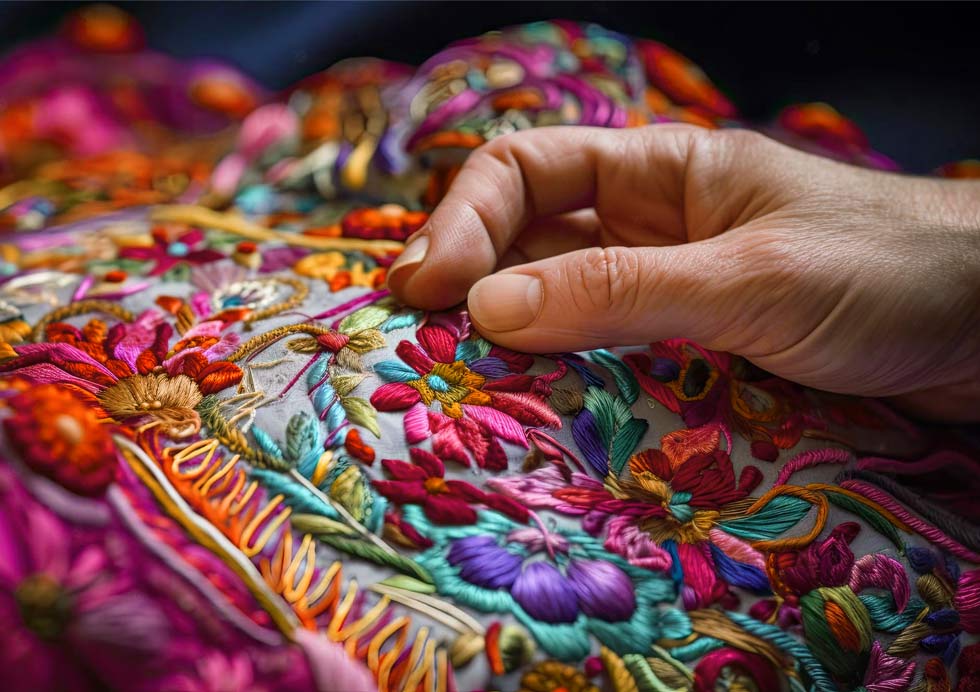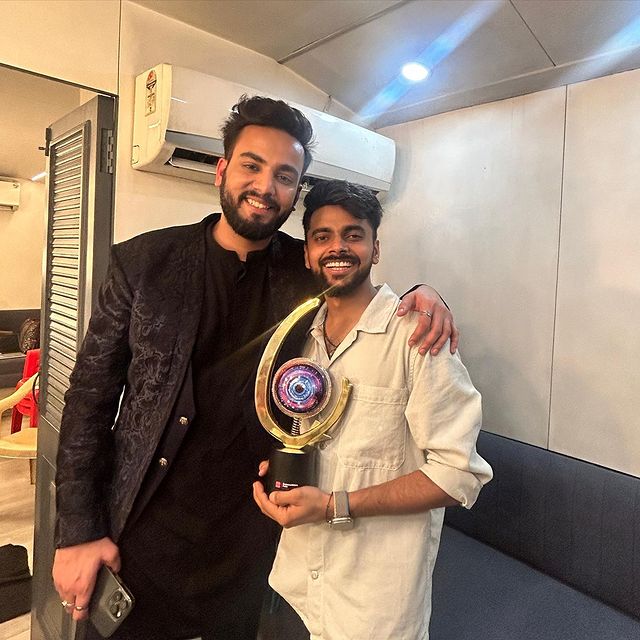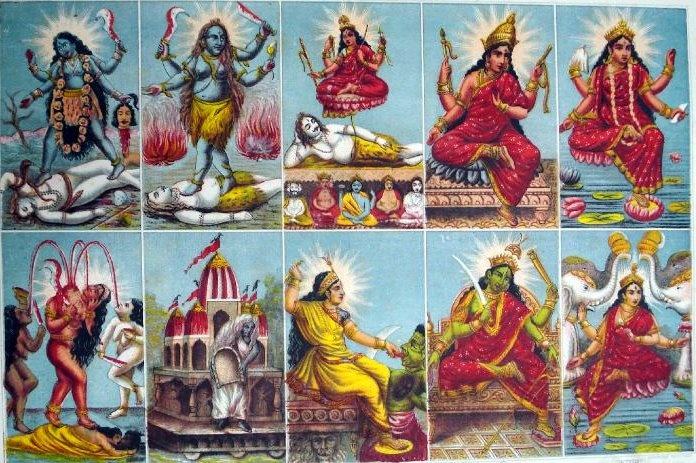Embroidery is a captivating and artistic form that enchants with its soothing charm and enthralling techniques. India celebrated for its opulent legacy of art and culture, stands as a treasure trove in the realm of magnificent embroidery. The diverse regions of India proudly boast their unique Indian embroidery styles, each characterized by distinct elements such as the choice of fabric, intricate patterns, stitch sizes, single or multiple stitch techniques, and embellishments like mirror work.
In this topic, we will claw into the colorful world of Indian embroidery, examining the uproariously, distinctness, and special traits that identify each type. Indian embroidery is a beautiful art form that highlights the country’s rich artistic heritage and workmanship. We will look at the exquisite complications, designs, motifs, and ways that distinguish each kind of Indian embroidery. From the brilliant colors of Kashmiri embroidery to the complex threadwork of Chikankari, and from the foamy glasswork of Gujarat to the luxurious zardozi of Lucknow, we will uncover the history and features underpinning each embroidery style. Join us on this trip to learn the beauty and significance of Indian embroidery, as well as the art that makes it so unique.
Indian Embroidery Varieties By Region
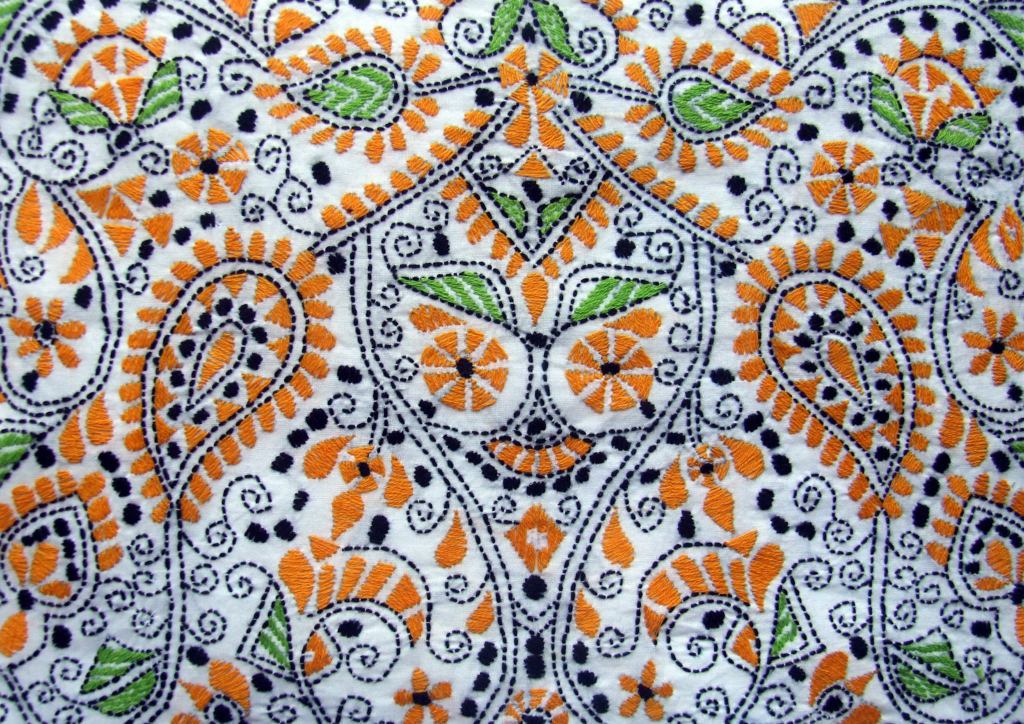
Kantha Embroidery: A Rich Heritage from West Bengal
Kantha embroidery, originating from the vibrant state of West Bengal, is a remarkable art form that showcases intricate running stitches. This technique involves creating beautiful motifs and patterns on various fabrics, including sarees and quilts.
With its roots deeply embedded in the culture and tradition of West Bengal, Kantha embroidery has been passed down through generations. Skilled artisans meticulously stitch rows of running stitches, often in contrasting colors, to form elaborate designs. The stitches, known as “kantha stitches,” follow the contours of the motifs and create a textured effect.
Kantha embroidery motifs can range from depictions of birds, animals, and flowers to geometric patterns and human figures. Each design holds symbolic significance, reflecting the artistic sensibilities and storytelling traditions of the region.
Traditionally, Kantha embroidery was done using recycled cloth and threads, giving new life to old garments and fabrics. This sustainable practice adds a unique charm to the art form and highlights its resourcefulness.
Today, Kantha embroidery has gained global recognition for its exquisite craftsmanship and visual appeal. It is widely admired for its intricate detailing, delicate patterns, and ability to bring life and vibrancy to fabrics.
Whether adorning sarees, dupattas, home decor items, or fashion accessories, Kantha embroidery continues to be a cherished part of West Bengal’s cultural heritage. Its timeless beauty and artistry serve as a testament to the rich traditions and skilled craftsmanship of the region.
Chikankari: The Delicate Art of Lucknow
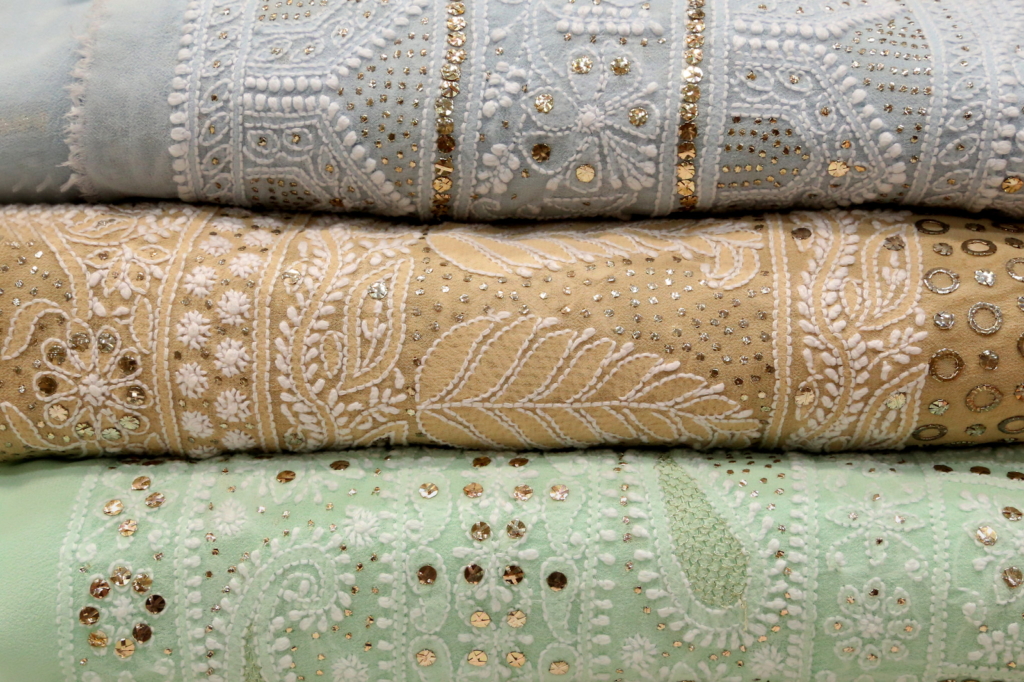
Chikankari, a specialty of Lucknow in Uttar Pradesh, is a renowned form of embroidery design known for its delicate white threadwork. This exquisite artistry is typically performed on muslin or cotton fabric, resulting in elegant patterns that include intricate floral motifs, paisleys, and vines.
Chikankari embroidery is characterized by its fine, skillfully executed stitches, which are often done with white thread, although colored threads are occasionally used for variation. The embroidery technique involves a combination of stitches, such as the shadow stitch, stem stitch, and French knot, among others. These stitches are meticulously worked to create a textured and visually appealing surface.|
The art of Chikankari has been passed down through generations in Lucknow, with artisans dedicating hours of intricate handwork to bring forth intricate designs. It requires precision, patience, and a keen eye for detail. Chikankari is not only limited to garments like sarees, salwar suits, and dupattas but has also found its way into home furnishings and accessories.
Chikankari is more than just an embroidery design; it is an inseparable facet of Lucknow’s cultural legacy. Its enduring grace and refinement have positioned it as a coveted preference for individuals desiring a dash of sophistication in their attire. The craft continues to evolve, combining traditional designs with contemporary aesthetics, ensuring that Chikankari remains a cherished art form that represents the rich heritage of Lucknow.
Phulkari: The Beauty of Punjab
Phulkari embroidery, originating from Punjab, is a captivating art form renowned for its vibrant and flower-filled patterns. Traditionally crafted on coarse cotton fabric, Phulkari showcases a burst of colors through its intricate threadwork.
In Phulkari, the essence lies in the vibrant use of threads that create mesmerizing floral motifs and geometric designs. The embroidery is done with great precision and skill, often featuring a mix of bold and intricate stitches. The lively color palette includes hues like red, orange, pink, and yellow, symbolizing joy and celebration.
This traditional craft holds cultural significance and is often passed down through generations. Phulkari embroidery adorns various garments, including shawls, dupattas, and traditional outfits like salwar kameez and lehengas, adding a touch of beauty and tradition to the wearer’s attire.
Phulkari embroidery is not merely an art form; it reflects the rich heritage and creativity of Punjab. Its vibrant colors and intricate patterns continue to captivate art enthusiasts and fashion lovers alike, making Phulkari a cherished symbol of Punjab’s cultural identity.
Zardozi: The Embellishing Embroidery
Zardozi embroidery practiced in Lucknow, Uttar Pradesh, is renowned for its intricate metal threadwork, typically crafted using gold or silver, to embellish luxurious fabrics such as silk and velvet. Lucknow serves as a prominent center for this opulent art form.
Zardozi embroidery involves the meticulous wrapping of silk thread with genuine gold and silver threads, resulting in embroidery that exudes grandeur. Beyond the use of precious metals, this art form incorporates other embellishments like beads, semi-precious stones, sequins, and pearls. The mastery of Zardozi embroidery is often passed down through generations, with its pinnacle achieved during the Mughal reign.
Characterized by its three-dimensional effect, elaborate designs, motifs, and patterns, Zardozi stands out as a distinctive embroidery style. It can be further categorized into two types: Karchobi and Kamdani.
Karchobi is recognized by its dense stitches on heavy base materials like velvet or satin. It is commonly found on garments such as coats, tent coverings, furnishing, and canopies. On the other hand, Kamdani refers to the lighter, more delicate work, which finds popularity in Rajasthan.
Kamdani embellishes elegant fabrics like silk and muslin. While traditionally suited for scarves and veils, this style has become prominent in modern Indian bridal wear.
Zardozi embroidery, with its rich history and exceptional craftsmanship, continues to captivate with its regal beauty and intricate detailing, adding a touch of opulence to the world of textiles.
Kashmiri Embroidery
Kashmiri embroidery stands as a testament to the exceptional artistry and craftsmanship of the region. Renowned for its elaborate patterns portraying flowers, leaves, and vines, this embroidery style enchants through its meticulous needlework, predominantly employing chain stitches. Now, let’s delve into the various forms of Kashmiri embroidery:
- Crewel Embroidery: The hallmark of Crewel embroidery lies in its utilization of delicate threads, typically crafted from wool to fashion intricate motifs. These embroidery designs frequently feature floral patterns, with vibrant hues enhancing the fabric, thereby yielding a sumptuous and textured appearance.
- Needlework (Sozni): Sozni embroidery is a delicate needlework technique that involves fine, intricate stitching using silk threads. Skilled artisans create mesmerizing patterns, showcasing the beauty of nature, architecture, and traditional motifs.
- Tilla Embroidery, alternatively referred to as Zari or Zardozi represents a prominent form of Kashmiri embroidery. It entails the use of metallic threads, including opulent silver and golden strands. This intricate technique imparts a sense of opulence and a subtle shimmer to the fabric, rendering it particularly well-suited for festive and ceremonial garments.
- Aari Embroidery: Aari embroidery is performed using a hooked needle, known as an “Aari,” to create intricate chain stitch patterns. This technique allows for precise detailing, resulting in stunning designs that adorn shawls, stoles, and garments.
Every variety of Kashmiri embroidery beautifully exemplifies the region’s opulent heritage and artistic mastery. With their vivid palettes, elaborate patterns, and flawless artistry, these embroidery techniques persist in being highly cherished and revered within textiles worldwide.
Mirror Work Embroidery
Mirror Work embroidery, originating from the regions of Gujarat and Rajasthan, is a captivating art form that reflects the colorful cultural heritage of these states. This traditional technique involves the skillful attachment of small mirrors or shisha onto fabrics using vibrant threads, resulting in a mesmerizing and dazzling effect.
In mirror work, the artisans meticulously stitch mirrors of various shapes, sizes, and designs onto textiles, such as sarees, dupattas, and garments. The mirrors are secured using intricate and decorative stitches, enhancing the overall aesthetic appeal of the embroidered piece.
The vibrant colors used in mirror work embroidery, often seen in shades of red, yellow, green, and blue, add to the liveliness and exuberance of the finished product. The play of light on the mirrors creates a delightful interplay of reflections, infusing the artwork with a sense of radiance and joy.
Historically, mirror work embroidery was prevalent in the traditional attire of Gujarat and Rajasthan, worn during celebratory occasions and festivals. Mirrorwork not only embodies a rich cultural heritage but also infuses a touch of glamor into clothing. With time this form of embroidery has expanded its horizons to encompass a diverse range of items, extending beyond clothing to include home decor, accessories, and contemporary fashion ensembles.
This traditional embroidery technique continues to thrive, captivating admirers with its shimmering beauty and representing the enduring legacy of Gujarati and Rajasthani culture.
Whether adorning a vibrant wall hanging, embroidery designs for a blouse, an intricately embellished bag, or a stunning ethnic garment, mirror work embroidery adds a touch of splendor and cultural richness to any piece, making it a true testament to the vibrant traditions of Gujarat and Rajasthan.
Gota Patti: The Glamor Embroidery
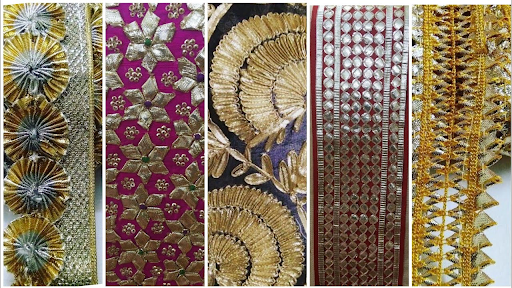
Gota Patti embroidery is a traditional Rajasthani skill notable for its beautiful gold or silver ribbon work. This method delicately weaves metallic ribbons onto fabrics to create attractive and detailed patterns. Gota Patti needlework is commonly used to adorn a wide range of Indian women’s clothes, including suit-salwar, lehengas, sarees, and dupattas.
Gota Patti embroidery lends a sense of glitz, beauty, and luxury to traditional clothing. Each piece is unique and visually attractive because of the exquisite craftsmanship and attention to detail in crafting elaborate designs. Metallic ribbons give the cloth a rich and sumptuous look, making it great for festive gatherings, weddings, and festivities.
Gota Patti embroidered themes and patterns are frequently inspired by nature, such as flowers, leaves, vines, and paisley designs. These designs are painstakingly handmade by trained artisans who mold and sew metallic ribbons into magnificent compositions.
Gota Patti needlework not only adds to the visual appeal of the clothing, but it also has cultural importance. It is firmly established in Rajasthan’s customs and heritage and is seen as a sign of majesty and grandeur. The craft has been passed down through generations, with artists polishing their talents and creating enduring works of art.
Gota Patti needlework, with its glistening beauty and precise artistry, is adored and admired by people all over the world. It is still an important feature of Indian fashion.
Kasuti Embroidery
Kasuti embroidery, a traditional craft from Karnataka, beautifully encapsulates the essence of the region’s culture and traditions. This intricate form of handmade embroidery holds significant meaning for the women artisans involved. The term “Kasuti” derives from the combination of two words: “Kai,” meaning hand, and “suti,” representing cotton.
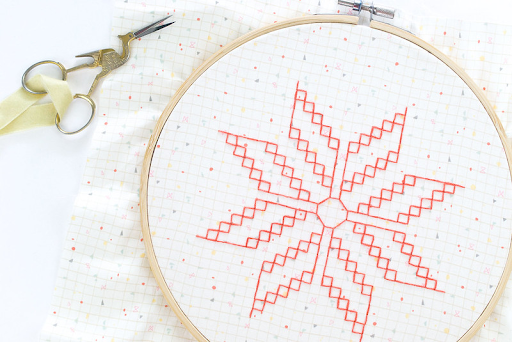
The art of Kasuti embroidery showcases a variety of motifs, including temple architecture, birds, lotus flowers, and captivating patterns. The craftsmanship is brought to life through the skilled use of four primary stitches: Gavanti, Murgi, Negi, and Menthi. These stitches combine to create mesmerizing geometric embroidery designs and intricate detailing.
Kasuti embroidery not only adds a touch of elegance to silk or cotton fabrics but also serves as a testament to the rich cultural heritage of Karnataka. It is a cherished craft that celebrates the artistry and creativity of the region’s skilled artisans.
Indian embroidery encompasses a variety of styles that exhibit regional distinctions. Each embroidery type possesses its own distinct significance, narrative, and exceptional attributes.

